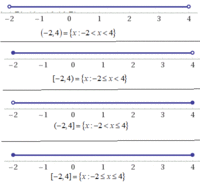ThunderBalls97
New member
- Joined
- Feb 9, 2020
- Messages
- 9
I'm doing functions in maths but don''t know what including or not including means.
Can you please give us some examples where those two terms are used - and you don't understand?I'm doing functions in maths but don''t know what including or not including means.
You donot mention INCLUDING or NOT INCLUDING in your statement above.Its not really an example its just the basics where you have the white dots and he black dots.
Please give a quotation/s from your textbook (indicating your confusion).Well in the textbook it talks about including and not including so what does it mean
I think this what you mean. I do not think it is a joke at all.I'm doing functions in maths but don''t know what including or not including means.

If we say that \(x\ge 2\) that is read "x is at least two". Now is \(2\) included or not?So why do numbers have to be included
No 3 is not includedIf we say that \(x\ge 2\) that is read "x is at least two". Now is \(2\) included or not?
If we say that \(3<y\) that is read "y is greater than three". Now is \(3\) included or not?
